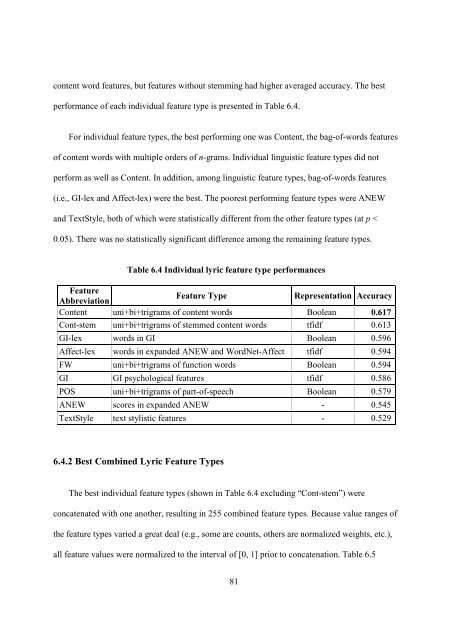improving music mood classification using lyrics, audio and social tags
improving music mood classification using lyrics, audio and social tags
improving music mood classification using lyrics, audio and social tags
You also want an ePaper? Increase the reach of your titles
YUMPU automatically turns print PDFs into web optimized ePapers that Google loves.
content word features, but features without stemming had higher averaged accuracy. The best<br />
performance of each individual feature type is presented in Table 6.4.<br />
For individual feature types, the best performing one was Content, the bag-of-words features<br />
of content words with multiple orders of n-grams. Individual linguistic feature types did not<br />
perform as well as Content. In addition, among linguistic feature types, bag-of-words features<br />
(i.e., GI-lex <strong>and</strong> Affect-lex) were the best. The poorest performing feature types were ANEW<br />
<strong>and</strong> TextStyle, both of which were statistically different from the other feature types (at p <<br />
0.05). There was no statistically significant difference among the remaining feature types.<br />
Table 6.4 Individual lyric feature type performances<br />
Feature<br />
Abbreviation<br />
Feature Type<br />
Representation Accuracy<br />
Content uni+bi+trigrams of content words Boolean 0.617<br />
Cont-stem uni+bi+trigrams of stemmed content words tfidf 0.613<br />
GI-lex words in GI Boolean 0.596<br />
Affect-lex words in exp<strong>and</strong>ed ANEW <strong>and</strong> WordNet-Affect tfidf 0.594<br />
FW uni+bi+trigrams of function words Boolean 0.594<br />
GI GI psychological features tfidf 0.586<br />
POS uni+bi+trigrams of part-of-speech Boolean 0.579<br />
ANEW scores in exp<strong>and</strong>ed ANEW - 0.545<br />
TextStyle text stylistic features - 0.529<br />
6.4.2 Best Combined Lyric Feature Types<br />
The best individual feature types (shown in Table 6.4 excluding “Cont-stem”) were<br />
concatenated with one another, resulting in 255 combined feature types. Because value ranges of<br />
the feature types varied a great deal (e.g., some are counts, others are normalized weights, etc.),<br />
all feature values were normalized to the interval of [0, 1] prior to concatenation. Table 6.5<br />
81
















